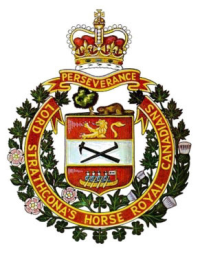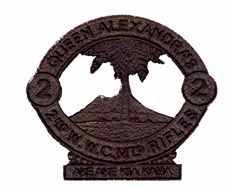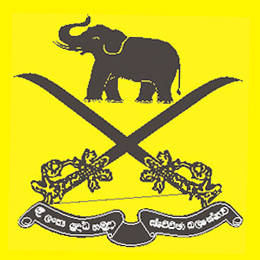History
The regiment start out as the cavalry element of the Ceylon Light Infantry attached to the Ceylon Light Infantry Volunteers in 1887 (that was in 1910 renamed Ceylon Defence Force) and was named as the Ceylon Mounted Infantry (CMI) .
In 1897, the regiment was represented at the Diamond Jubilee Celebrations of Queen Victoria, in full dress uniform, which consisted of white helmet, scarlet tunic, white breeches and jack boots.
The first deployment of the regiment can in 1900 a company-sized force under the command of Major Murray Menzies, was sent to South Africa for the Boer War experiencing combat at Stinkhoutboom, Cape Colony, Driefontein, Johannesburg, Diamond Hill and Wittebergen. After the CMI was withdrawn, another company-sized force from the Ceylon Planters Rifle Corps was in 1902 dispatched to South Africa. The overall conduct of Ceylon troops received accolades from General Kitchener, Chief of Staff to Lord Roberts in South Africa, who affirmed, "The Ceylon Contingent did very good work in South Africa I only wish we had more of them." For the service in South Africa a regimental guidon was presented by Prince George, Duke of York (later King George V), on the occasion of his visit to Kandy. On February 18, 1901 Governor of Ceylon Sir West Ridgeway unveiled a Memorial Window in St. Paul's Church, Kandy for the eight members of the CMI who had been killed in the Boer War. Shortly thereafter regiment was represented at the coronation of King Edward VII by a contingent under the command of Lieut. J.N. Campbell. The unit was based in Kandy and regularly gave Mounted Escorts for members of the Royal family who visited Ceylon.
In 1906 the CMI was renamed the Ceylon Mounted Rifles and shortly had created a mechanized squadron. It was mobilized for war in 1914 when World War I started. In 1928 the CMR Polo Club was formed.
On Armistice Day 1931, the old regimental guidon was laid up for safe keeping at St. Paul's Church, Kandy where the second was laid up for safe keeping after the regiment was disbanded. With the demise of cavalry warfare the regiment was disbanded in 1938. At its disbandment most of its personal were transferred to the Ceylon Planters Rifle Corps.

Lord Strathcona's Horse (Royal Canadians) (LdSH[RC]) is a regular armoured regiment of the Canadian Army and is Canada’s only tank regiment. Currently based in Edmonton, Alberta, the regiment is part of 3rd Canadian Division's 1 Canadian Mechanized Brigade Group. Members of the regiment are commonly called Strathconas or Strats as a short form. It was one of the last regiments in the British Empire to be created and raised by a private individual, Donald Alexander Smith, 1st Baron Strathcona and Mount Royal.
The Ceylon Defence Force (CDF) was established in 1910 by the Ceylonese legislation Ceylon Defence Force Ordinance, which reformed the Ceylon Volunteer Force (CVF) that existed previously as the military reserve in the British Crown colony of Ceylon. At the time of forming it was only a reserve force but soon developed into a regular force responsible for the defence of Ceylon. The CDF was under the command of the General Officer Commanding, Ceylon of the British Army in Ceylon if mobilised. However mobilisation could be carried out only under orders from the Governor.

The Royal Canadian Dragoons (RCD) is the senior armoured regiment of the Canadian Army by precedence. It is one of three armoured regiments in the Regular Force and forms part of the Royal Canadian Armoured Corps.

The 1st Hussars is an armoured Primary Reserve regiment of the Canadian Armed Forces, based in London and Sarnia, Ontario.

Queen Alexandra's Mounted Rifles (QAMR) is an armoured regiment of the New Zealand Army and forms part of the Royal New Zealand Armoured Corps. The regiment was formed in 1864 and is currently an armoured cavalry unit equipped with NZLAV.

The Waikato Mounted Rifles (WMR) is the New Zealand Army's only Territorial Force squadron of the Royal New Zealand Armoured Corps (RNZAC). The Squadron's origins can be traced back to 1869 when the first mounted unit was raised in the Waikato. Today the Squadron is part of Queen Alexandra's Mounted Rifles (QAMR) where it forms the regiment's reserve squadron. WMR's role is mounted reconnaissance and surveillance.

The Imperial Yeomanry was a volunteer mounted force of the British Army that mainly saw action during the Second Boer War. Created on 2 January 1900, the force was initially recruited from the middle classes and traditional yeomanry sources, but subsequent contingents were more significantly working class in their composition. The existing yeomanry regiments contributed only a small proportion of the total Imperial Yeomanry establishment. In Ireland 120 men were recruited in February 1900. It was officially disbanded in 1908, with individual Yeomanry regiments incorporated into the new Territorial Force.

The 2nd/14th Light Horse Regiment is a regiment of the Australian Army and forms part of the Royal Australian Armoured Corps. The regiment is an Australian Light Horse unit, and has been widely romanticised and popularised in literature and poetry throughout the 20th century. The unit sentimentally traces its lineage to 1860 and is the oldest Australian Regular Army unit through antecedent units the 2nd Moreton Light Horse (QMI) and the 14th West Moreton Light Horse (QMI). The regiment is assigned to 7th Brigade based in Brisbane and is equipped with the M1A1 Abrams tank and the ASLAV reconnaissance vehicle.

The Chief Langalibalele Rifles is a reserve infantry regiment of the South African Army.

The Buffalo Volunteer Rifles (BVR) is an infantry regiment of the South African Army. As a reserve unit, it has a status roughly equivalent to that of a British Army Reserve or United States Army National Guard unit.
The Cape Colonial Forces (CCF) were the official defence organisation of the Cape Colony in South Africa. Established in 1855, they were taken over by the Union of South Africa in 1910, and disbanded when the Union Defence Forces were formed in 1912.

The 12th Manitoba Dragoons is an armoured regiment of the Canadian Army that is currently on the Supplementary Order of Battle.

The Sri Lanka Army Volunteer Force (SLAVF) is the active-duty volunteer reserve force of the Sri Lanka Army. The SLAVF is separate from the Regular Force which consists of personal who are professional soldiers and its Regular Reserve, which comprises personal who have a mobilization obligation following their service in the regular army. The SLAVF consists of the volunteer force and the volunteer reserve; administration and recruitment of reserve personal is carried out by the Volunteer Force Headquarters in Shalawa, Kosgama which is headed by the Commandant of the Volunteer Force. It has a current strength of about 55,000 personnel. The SLAVF was known as the Ceylon Volunteer Force from 1949 to 1972 and the Sri Lanka Volunteer Force from 1972 to 1985.
The Ceylon Planters Rifle Corps was a regiment of the Ceylon Defence Force, which existed between 1900 and 1949. It was a volunteer (reserve) regiment based in Kandy, made up of only Europeans that were tea and rubber planters of the hills of Sri Lanka. The regiment deployed personnel to fight in the Second Boer War, the First, and Second World Wars.

The Duke of Lancaster's Own Yeomanry (DLOY) was a yeomanry unit of the British Army from 1798 to 1992. Originally raised as part-time cavalry for home defence and internal security, the regiment sent mounted infantry to serve in the Second Boer War. During World War I it carried out mounted duties in Egypt and Palestine and on the Western Front. By 1917 the reserve units at home had become cyclists and the regiment serving on the Western Front joined an infantry battalion, seeing action at the Battle of Passchendaele, against the German Spring Offensive and in the final Allied Hundred Days Offensive. At the beginning of World War II the regiment gave up its horses and formed two regiments of medium artillery, which served in the Middle East, Italy and North West Europe. Postwar it became an armoured unit. Today its lineage is maintained by B Squadron, the Queen's Own Yeomanry.
The Royal East Kent Yeomanry was a British Army regiment formed in 1794. It saw action in the Second Boer War and the First World War.

The 3rd/9th Light Horse is a Reserve light cavalry regiment of the Australian Army based in Smithfield, South Australia. It is constituted of a single squadron. It is part of the Royal Australian Armoured Corps (RAAC), the regiment is attached to the 9th Brigade, and currently operates Hawkei Protected Mobility Vehicle - Light (PMV-L). On 26 October 2022, 9th Brigade transitioned as a Direct Command to Forces Command (FORCOMD) as part of an Army wide transformation. 3rd/9th Light Horse, 1st Armoured Regiment officially commenced on 1 November 2022.

The 2nd Canadian Mounted Rifles Battalion, was authorized on 7 November 1914 as the 2nd Regiment, Canadian Mounted Rifles, CEF. The battalion recruited in Victoria and Vernon, British Columbia and was mobilized in Victoria. An earlier incarnation was raised for Boer War.
The New South Wales Mounted Rifles was a mounted infantry regiment of the Colony of New South Wales.

The South Australian Mounted Rifles (SAMR) was a mounted infantry unit of the Colony of South Australia that served in the Second Boer War. The first contingent of South Australian Mounted Rifles was raised in 1899, followed by a second contingent in 1900.














